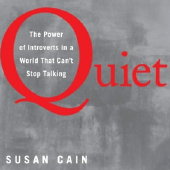The Power of Introverts, the Power of Quiet
Susan Cain’s new book “Quiet: The Power of Introverts in a World That Can’t Stop Talking” argues that introverted people who value quiet and solitude to be creative are as able as extroverts to be transformative leaders.
Topics

“‘Quiet leadership’ is not an oxymoron” is one of 16 points on author Susan Cain’s manifesto about the power of introverts.
“Research strongly suggests that people are more creative when they enjoy privacy and freedom from interruption.”
So wrote Susan Cain in a New York Times opinion piece earlier this month. Her first book, Quiet: The Power of Introverts in a World That Can’t Stop Talking (Crown Publishers, 2012), was released last week.
In the Times essay, Cain argues that “the most spectacularly creative people in many fields are often introverted, according to studies by the psychologists Mihaly Csikszentmihalyi and Gregory Feist.” Csikszentmihalyi is a professor of psychology and management at Claremont Graduate University and Feist is an associate professor of psychology at San Jose State University.
Cain, a corporate lawyer turned author, rues the lack of quiet in our lives and the toll it can take on our productivity and innovation:
The New Groupthink has overtaken our workplaces, our schools and our religious institutions. Anyone who has ever needed noise-canceling headphones in her own office or marked an online calendar with a fake meeting in order to escape yet another real one knows what I’m talking about. Virtually all American workers now spend time on teams and some 70 percent inhabit open-plan offices, in which no one has “a room of one’s own.”
The big safety net for introverts in the workplace? Group interactions that occur digitally. “The protection of the screen mitigates many problems of group work,” Cain writes. “This is why the Internet has yielded such wondrous collective creations. Marcel Proust called reading a ‘miracle of communication in the midst of solitude,’ and that’s what the Internet is, too. It’s a place where we can be alone together — and this is precisely what gives it power.”
Cain notes in Quiet’s video book trailer that introverts are leaders as well as innovators. “Einstein, Gandhi, Rosa Parks, Van Gogh — all these people were transformative leaders and all of them were introverts who accomplished what they did because of their quiet temperaments, not in spite of them.”
Cain’s website, thepowerofintroverts.c

Comments (3)
» BYOD Workplace Training — Bridging Gaps Between Solitude and Groupthink » Anywhere Pad » board portal for board meetings on iPad, Android, and iPhone
Creativity Finds Its Genesis Alone | Geoff Livingston's Blog
d.moses